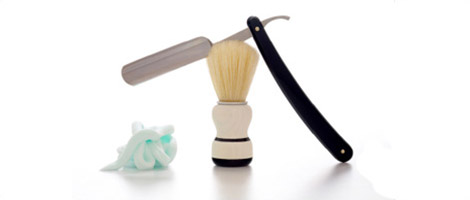
Self-Examination - Testicle
Most guys play with their balls for fun, but who would have thought that 'playing' with them could save your life?
All joking aside, the fact is that every man between the ages of 18 and 40 could (and should) be doing a monthly testicle self-exam for the good of their health. While fairly rare, testicular cancer does affect a small percentage of men every year, so it pays to take a minute or two once a month, just to check. Doing these tests regularly, and early, means you will have a base line - a 'healthy you' to compare to if anything does happen to go sideways with your 'boys'.
And here's more good news; when caught early, testicular cancer is highly treatable and personal recovery rates are very high, nearing 100%. Basically, if you catch it early enough, it's one of the easiest forms of cancer to treat successfully. So get on it!
Testicular Cancer Risk Factors
The National Cancer Institute states that testicular cancer affects the greatest number of men between the ages of 20 and 35. Around 7,000 men in North America contract it annually, but it is only fatal to about 300.
The higher risk individuals in North America are Caucasians age 18 – 40 years old. In fact, Caucasians are over four times more likely than African-Americans to contract testicular cancer. Additional factors include if you have an un-descended testicle or late descended testes, or if your family has a history of cancer. Also, if you have had testicular cancer before, there is about a 3 - 4 % chance that you will have it again at some point in the other testicle. The lesson here: keep on watching for it, just to be safe.
Think you might have testicular cancer? Sustained swelling and pain in your testes are typical signs, but if this happens you can already see that something is wrong. Don't waste time, see a physician right away. Next we'll go into how to do a preliminary test on yourself.
What to look for
Step one is to get familiar with the normal shape and feel of your own body. Familiarize yourself with the natural structures on and around the testicles that feel like 'lumps' so you don't panic the first time you do a self-exam.
The first thing you will find (during your first testicle self-exam) is the Epididymis. This is a cord or tube-like structure on both sides of each testicle, and is a normal structure. It may take a few tries to know what this is supposed to feel like. Feel gently beneath this tube when you do your gentle roll.
You may also find blood vessels and other structures which may throw you off the first time. These can differ slightly with each man, so you need to find these out for yourself. Once you have done a few self exams, you'll be familiar with 'what goes where', and what feels 'normal' for your own testicles. This is your base line. Now future self-exams will tell you if something changes.
An actual lump or nodule will feel different than the structures mentioned above. What you are watching for is anything that is different, such as the following:
Irregularities can include hard lumps, general harness of the testicle, and tenderness or general discomfort. Very hard (abnormal) lumps on the testicles of any size may appear. Nearly as hard as bone, these will nearly always be found only on one testicle. Hardness in the entire testicle may be a tumor, but may also indicate a cyst inside the testicle (i.e. not cancer). Tenderness or general discomfort is not often a cancer symptom alone, but should be checked if no other reason can be found for it.
Other signs can include the following:
- Changes in size of either testicle, either shrinking or enlargement
- Fluid collecting in the scrotum (the sac of skin around the testes)
- 'Heavy' feeling testicles (when not in hand)
- Groin or abdominal pain (or in the scrotum itself)
- Enlargement or tenderness in the male breast
What to do if you find a 'lump'
So what happens if you find something that wasn't there before? Well the first thing is not to panic! There are many things that are NOT CANCER that can affect the size, shape, and structure of your testicles. But you don't want to take any chances, so the very next thing you should do is to visit a physician and have a professional assessment.
If you find something new, it doesn't mean that it's cancer! Infections (cysts) can also result in swelling, so don't jump to conclusions. If you find one of these symptoms, or any other that gives you concern, see a physician or urologist right away. Taking steps sooner is better than leaving it to chance later.
The 'How To'
First of all a quick word of advice: this self-exam is meant to help you with an early warning, not to diagnose yourself. Your physician or urologist is better qualified to make a diagnosis than you, so remember this if you ever find anything. You can help by raising the alert, but that's about all. Leave the professionals to make the final call.
Follow these basic steps:
- Easiest after a shower or bath, as the heat and moisture make the testicles drop down, and the skin of the scrotum becomes soft, making it easier to feel the surface of the testicles beneath.
- Take a seat or lay down, whatever you feel is most comfortable.
- Move the penis out of the way
- Examine one testicle at a time
- Hold in one hand and feel with the other
- Hold the testicle between the forefinger and thumb and roll it gently around
- Work around obstacles (first focus on learning what the normal structures feel like) and feel for the above mentioned 'irregularities'
- Follow up with the other testicle
- Repeat Monthly
A Final Word
You're never too young to start. As mentioned earlier, every man over the age of 18 is recommended to do this on a monthly basis. We'll say this again, because it's important …
If you find something, the most important thing is to immediately see a doctor. For the sake of your health, just do it. It may not be cancer, but would you bet your left (or right) nut on it – so to speak?
Think of it this way; it's yet another step you can take yourself to ensuring a long and healthy sex life, which is what this website is all about. Good health and good sex to you!



